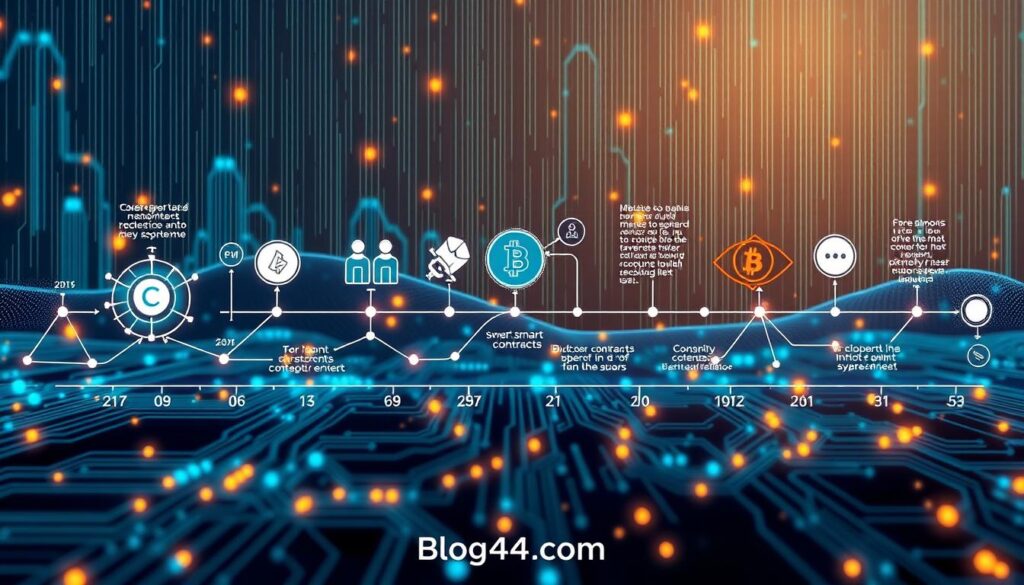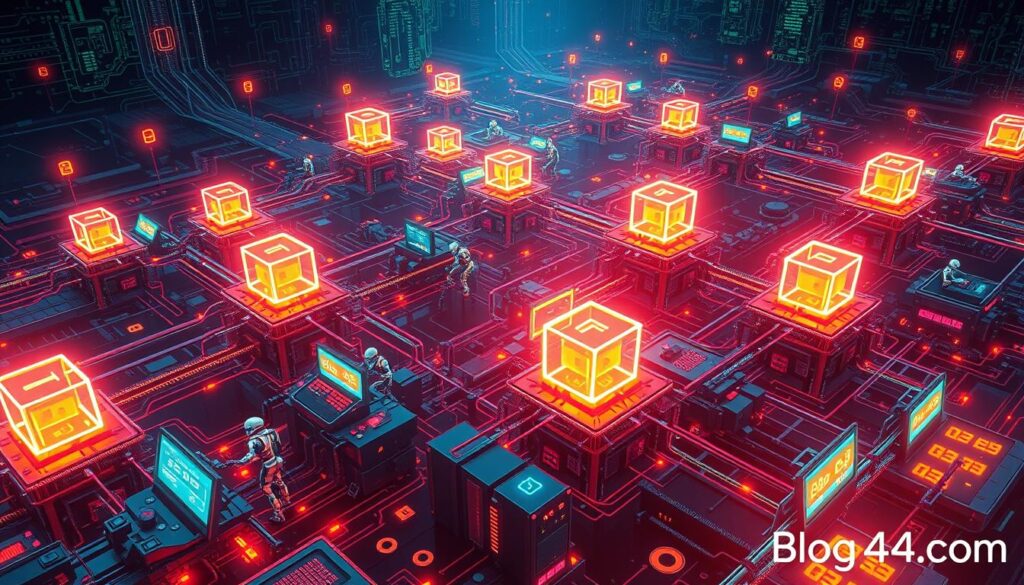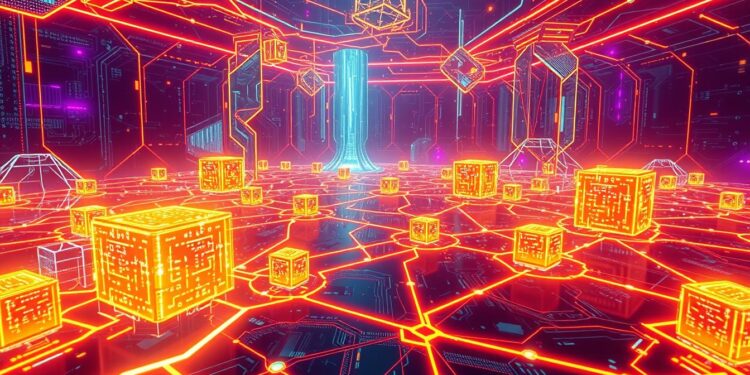Are you ready to unlock the transformative power of blockchain technology? This guide will take you on a journey through the world of distributed ledgers, cryptocurrencies, and a decentralized future. It’s a world that’s unfolding before our eyes.
Blockchain is more than just a buzzword. It’s a revolutionary technology reshaping industries and redefining trust. It empowers individuals like never before. From finance to healthcare, blockchain’s impact is far-reaching and undeniable.
In this article, we’ll explore blockchain’s fundamental principles and evolution. We’ll see how it works and its key components. We’ll also look at smart contracts and the security features that make it strong.
The true power of blockchain is in its real-world applications. We’ll examine how it’s transforming industries like finance and healthcare. We’ll also explore the exciting future blockchain has in store for us.
So, are you ready to unlock blockchain’s secrets? Discover how it can revolutionize business, asset management, and even democracy. Dive in and explore the endless possibilities this groundbreaking technology offers.
Key Takeaways
- Blockchain is a decentralized, distributed ledger technology that revolutionizes how data is recorded and shared.
- It offers transparency, security, and efficiency, with applications across diverse industries.
- Blockchain enables the immediate transfer of information through an immutable ledger, promoting trust and transparency.
- Cryptocurrencies like Bitcoin and Ethereum have delivered exponential returns, driving mainstream adoption of blockchain technology.
- Blockchain’s impact extends beyond finance, with use cases in supply chain management, healthcare, voting, and more.
Understanding the Fundamentals of Blockchain
Blockchain technology is changing how we handle data. At its core is the distributed ledger technology. This lets everyone see a record of transactions that can’t be changed. It makes data safe and builds trust in many fields.
Defining Distributed Ledger Technology
The distributed ledger technology is the base of blockchain. It’s like a shared database where everyone has a copy. This way, all transactions are checked and updated together, keeping data safe and unchanged.
Core Components of Blockchain Architecture
- Blocks: These contain the transaction data, which are then grouped and added to the blockchain.
- Miners: Individuals or entities responsible for creating new blocks and validating transactions through a process called mining.
- Nodes: The computers or devices that make up the blockchain network, maintaining a copy of the distributed ledger and verifying transactions.
The Evolution of Digital Ledgers
Blockchain has grown from simple digital ledgers to a more complex system. It now supports smart contracts and apps. This has opened up new ways to solve problems in finance, supply chains, and healthcare.
Learning about blockchain’s basics helps us see its huge impact. It’s all about the distributed ledger, its parts, and how digital ledgers have evolved.
“Blockchain technology provides immediate transfer of information, ensuring quick, secure, and accurate data sharing for informed decision-making in businesses.”
The History and Development of Blockchain Technology
Blockchain technology started with Bitcoin in 2009. It changed the world of digital money. Now, it’s used in many fields like finance, healthcare, and supply chain management.
At first, blockchain was linked to Bitcoin and other digital coins. But, as it grew, different types of blockchains appeared. These include private, public, permissioned, and consortium blockchains. Each has its own use for users and businesses.
In the mid-2010s, big companies started using blockchain. This caught the tech world’s eye. Giants like IBM and Maersk began exploring blockchain solutions.
Today, blockchain is becoming a key part of our digital world. It’s like the cloud was in Web2. The SEC’s approval of Bitcoin ETFs shows blockchain’s value in both private and public sectors.
Blockchain makes financial transactions faster and safer. It also brings transparency to supply chains and automates complex agreements. It supports decentralized finance (DeFi), offering financial services without middlemen. This opens up chances for global financial participation.
Blockchain is changing how businesses work in many areas. It’s becoming a big part of our digital world.

“The blockchain is an incorruptible digital ledger of economic transactions that can be programmed to record not just financial transactions but virtually everything of value.”
– Don Tapscott, author and blockchain expert
How Blockchain Works: A Technical Overview
Blockchain technology is changing how we handle data security and transparency. It uses cryptography, block formation, and consensus mechanisms to create a secure digital ledger. This ledger is decentralized and tamper-evident.
The Role of Cryptography
Blockchain uses advanced cryptography to keep data safe. It uses digital signatures, hash functions, and encryption to authenticate transactions and protect the network. This strong foundation is crucial for the blockchain ecosystem.
Block Formation and Validation
New transactions are grouped into “blocks” and added to the blockchain. Miners, a group of participants, create these blocks. They solve complex problems using their computing power.
Once a block is created, it’s shared with the network. Other nodes verify the transactions and add the block to their ledgers.
Consensus Mechanisms Explained
Consensus mechanisms ensure all nodes agree on the ledger’s state. Proof of Work (PoW) and Proof of Stake (PoS) are two well-known methods. In PoW, miners compete to solve problems. In PoS, validators stake their cryptocurrency to validate transactions.
These mechanisms prevent double-spending and ensure transactions are valid and secure. Understanding cryptography, block formation, and consensus mechanisms helps us see how blockchain works.
“Blockchain technology has the potential to transform the way we approach data security, transparency, and trust in the digital age.”
Key Components of a Blockchain Network
At the heart of blockchain technology is a decentralized network. It makes transactions secure, transparent, and efficient. This network has several key parts that keep it strong. Let’s dive into these important elements:
Nodes
The network has individual computers called nodes. These nodes are divided into Full Nodes, Partial Nodes, and Mining Nodes. Full Nodes keep all transactions. Partial Nodes store only transaction hash values. Mining Nodes validate and add transactions, seen in Proof of Work systems.
Distributed Ledger
The ledger is a shared, unchangeable record of all transactions. It can be Public Ledger, visible to everyone; Distributed Ledger, where nodes have a local copy; or Decentralized Ledger, with no central control.
Transactions
Transactions are the core of blockchain, showing value or information transfer. They include sender and receiver details, amounts, and digital signatures for authenticity.
Consensus Mechanisms
These algorithms ensure nodes agree on transaction validity. Examples are Proof of Work (PoW), Proof of Stake (PoS), and Delegated Proof of Stake (DPoS). Each has its own validation process.
Cryptography
Cryptography is key for securing transactions. It uses Hash Functions for data integrity, Digital Signatures for authenticity, and Public and Private Keys for secure signing.
These components work together to create a secure, transparent, and decentralized blockchain network. This network supports many applications and changes industries.

Smart Contracts and Their Applications
Smart contracts are self-executing agreements written in code. They automate agreements, cutting out the need for middlemen. This innovation has changed how businesses work, making things more efficient.
Automated Contract Execution
Smart contracts’ main advantage is automating contract execution. When conditions are met, they carry out agreed actions. This makes transactions faster, cheaper, and less prone to errors.
Use Cases Across Industries
Smart contracts are used in many fields. In finance, they make bond transfers and derivatives trading safe. They also help in supply chain management by making things more transparent. In real estate, they simplify property deals and manage rentals.
In insurance, they automate claims and check policy details. This shows how smart contracts can improve many areas.
| Industry | Smart Contract Application |
|---|---|
| Finance | Corporate bond transfers, derivatives trading |
| Supply Chain | Transparency and traceability |
| Real Estate | Property transactions, rental payments |
| Insurance | Automated claims processing, policy verification |
As blockchain tech grows, so does the use of smart contracts. They offer new ways to make business smoother and cheaper in many areas.
https://www.youtube.com/watch?v=iBTmWIVHmD8
The Role of Nodes and Miners in Blockchain
Blockchain technology needs a network of nodes and miners to stay safe and reliable. Blockchain nodes keep copies of the blockchain and check transactions. Miners create new blocks and add them to the blockchain.
Nodes are key in the blockchain world. They download, check, and store the blockchain’s history. Full nodes save the whole blockchain, making sure the network works well and past transactions can be verified.
Miners are the heart of the blockchain. They use powerful computers to solve hard math problems. This creates new blocks and keeps the network safe.
The mining game is tough, with miners competing based on their power. They get new cryptocurrency for adding a block. The reward halves every four years to keep the currency valuable.
| Metric | Value |
|---|---|
| Bitcoin Mining Difficulty (March 2024) | 79.35 trillion |
| Bitcoin Mining Reward (March 2024) | 6.25 BTC |
| Projected Bitcoin Mining Reward (April 2024) | 3.125 BTC |
| Projected Bitcoin Mining per 10 minutes (2032) | 0.78 BTC |
Getting nodes and miners to agree is vital for the blockchain’s health. Big changes, like the Ethereum London Hard Fork, need most nodes to agree to work.
In short, blockchain nodes and miners are crucial for the blockchain’s success. Their work keeps the network safe, reliable, and open to many uses.

Understanding Blockchain Security Features
Blockchain technology is changing the digital security world. It offers strong features to protect data and transactions from cyber threats. At its core are cryptographic hash functions, key to keeping information safe and private.
Cryptographic Hash Functions
Cryptographic hash functions are algorithms that turn any data into a unique, fixed-size hash value. These hash values are like digital fingerprints. They help spot any changes to the original data. This is crucial for blockchain security, allowing transactions to be validated without a central authority.
Immutability and Trust Mechanisms
Blockchain’s immutability means transactions can’t be altered or deleted once recorded. This is thanks to a network of nodes, each with a copy of all transactions. Any attempt to change a block is quickly caught, as the new block won’t match the old ones. This immutability builds trust, making the system transparent and secure for data exchange.
Blockchain’s security, including cryptography and immutability, makes it valuable for many uses. It’s used in finance, supply chain, healthcare, and identity management. As it grows, it will be more important for protecting digital assets and keeping information safe.
“Blockchain technology offers a unique combination of security features that make it an invaluable tool in the fight against cyber threats. Its immutability and cryptographic safeguards provide a level of trust and transparency that is unparalleled in the digital world.”
Enterprise Blockchain Solutions
Blockchain technology is changing fast, and enterprise solutions are leading the way. These systems meet specific business needs. They use private networks to control data access and who can join.
Enterprise blockchain improves efficiency, transparency, and security in many areas. This includes supply chain management and financial transactions. It uses blockchain’s unique features like decentralization and smart contracts to make things better.
The global enterprise blockchain market is growing fast. It’s expected to grow by 47.5% each year. By 2032, it could reach $287.8 billion, up from $9.6 billion in 2023.
Platforms like Ethereum, Hyperledger Fabric, and R3 Corda are popular for enterprise use. They offer features that meet business needs. These platforms focus on privacy, security, and cost to fit into existing systems.
Blockchain has many uses, from supply chains to real estate. In supply chains, the market is expected to grow a lot. It will go from $2.08 billion in 2024 to $9.77 billion by 2030.
In real estate, blockchain is used to make transactions transparent. For example, Dubai is using it to record all property deals. This makes the process more efficient and trustworthy.
As blockchain evolves, more businesses see its value. It offers a secure and transparent way to operate. By using blockchain, companies can grow and stay ahead in a digital world.
| Key Features of Enterprise Blockchain | Benefits of Enterprise Blockchain Solutions |
|---|---|
|
|

“Blockchain offers a decentralized network structure, reducing the risk of data breaches and fraud as there is no single point of failure, fostering trust between companies and stakeholders.”
As the global enterprise blockchain market grows, more businesses see its value. They use private networks and business applications to grow and stay ahead. Enterprise blockchain is a key to success in today’s digital world.
Blockchain’s Impact on Different Industries
Blockchain technology has grown beyond just cryptocurrencies. It’s now changing many industries. Its key features like decentralization and transparency are making old business models new again.
Financial Services Transformation
In finance, blockchain is changing how we do cross-border payments, trade finance, and securities trading. DeFi platforms, like Ethereum, are making banking faster and safer. Smart contracts help follow rules without needing people to check.
Supply Chain Management
Blockchain helps the supply chain by making it clear and secure. It lets companies check every step of the supply chain, cutting down on fraud and building trust with customers. It makes supply chains run smoother and keeps fake products out.
Healthcare Applications
In healthcare, blockchain keeps data safe and lets it be shared right. It helps keep patient data secure and only share it with the right people. This improves privacy and helps patients take charge of their health.
Blockchain is also being used in real estate, energy trading, and digital identity. It shows how versatile and powerful it is. As more people use blockchain, it will change how businesses work, making things more open, safe, and efficient.
The Future of Blockchain Technology
Blockchain technology is growing fast, with many new uses on the horizon. It’s set to change how we do business, making things more open and efficient. This includes better data management and new ways to govern.
One big area of focus is making blockchain more eco-friendly. The tech has a big carbon footprint, so it’s being improved to use less energy. This is key for it to become widely accepted and help the planet.
Another big trend is central bank digital currencies (CBDCs). Banks are looking into digital money, using blockchain to make it safe and easy to use. This could make money transfers faster and more accessible, reducing our need for old-fashioned cash.
Blockchain networks are also getting better at working together. This means data and money can move easily between different systems. It’s a big step towards making blockchain even more useful across many industries.
Web3 is another exciting area. It’s a decentralized internet built on blockchain, aiming to give more power to users. It could change how we use the internet, making it fairer and more open.
Looking ahead, blockchain will change how we do business and interact online. It will make things more transparent and efficient. As it keeps improving, its impact on our world will grow even bigger.

| Key Blockchain Trends | Projected Impact |
|---|---|
| Energy-efficient blockchain solutions | Driving mainstream adoption and aligning with sustainability goals |
| Central Bank Digital Currencies (CBDCs) | Streamlining cross-border transactions and enhancing financial inclusion |
| Increased blockchain interoperability | Enabling seamless data exchange and collaborative applications across industries |
| Web3 development | Creating a more equitable, transparent, and user-centric digital ecosystem |
The future of blockchain is bright and full of possibilities. It will change many industries and how we use the internet. With improvements in energy use, CBDCs, and Web3, blockchain’s impact will be huge.
Challenges and Limitations of Blockchain
Blockchain technology is growing, but it faces many challenges. These need to be solved for it to be widely used. Knowing these obstacles is key to its future.
Scalability Issues
Blockchain’s main problem is scaling. It can’t handle many transactions at once. This is unlike fast payment systems we use today.
Because of this, networks get slow, and fees go up. This makes using blockchain in real life hard.
Regulatory Concerns
Rules for blockchain and cryptocurrencies vary a lot. Without clear rules, it’s hard to use blockchain widely. Governments are worried about money laundering and taxes.
Fixing these issues is vital for blockchain’s future. New ways to make blockchain faster and clear rules are needed. This will help blockchain grow in many fields.
“Blockchain technology faces significant challenges in terms of scalability and regulatory uncertainty, which must be overcome for it to reach its full potential.”
Getting Started with Blockchain Development
Blockchain technology is changing the game in many industries. It’s making the digital world a new place. The demand for blockchain developers is growing fast. Experts say the blockchain market will grow a lot, reaching $1,431.54 billion by 2030.
To start in blockchain development, you need to know the basics. Learning about distributed ledger tech, consensus, and smart contracts is key. Knowing about Ethereum and Hyperledger is also a good start.
Programming skills are important too. Solidity, Rust, and Go are languages you should know. Solidity is used for Ethereum smart contracts, Rust for Solana, and Go for infrastructure.
As you learn more, keep up with the latest trends. Staying current helps you find new opportunities and stay relevant.
The blockchain world is changing finance and many other areas. With the right skills, you can lead in this exciting field. It’s a chance for a rewarding career.
“Blockchain technology is not just a new business model, it’s a whole new basis for frictionless digital cooperation.” – Don Tapscott, Co-Founder of the Blockchain Research Institute
The blockchain market is growing fast, offering many chances for developers. By joining this field, you can be part of a future filled with innovation and creativity.

Conclusion
Blockchain technology is changing how we manage data, make transactions, and trust digital systems. It’s not just for cryptocurrencies anymore. It’s set to change many industries, from finance to healthcare.
Blockchain makes fast, cheap international payments possible, thanks to Ripple and Stellar. It also makes food safer and supply chains more transparent, thanks to IBM and Walmart. It can track a product’s journey, let people own parts of real estate, and improve healthcare data sharing.
But blockchain still faces challenges like privacy, energy use, and education needs, especially in poor countries. If we can solve these problems, blockchain could make our digital world safer, clearer, and fairer.
FAQ
What is blockchain technology?
Blockchain is a shared database that stores records on a distributed and decentralized ledger. It changes how companies work and do business. It offers transparency, security, and efficiency.
What is distributed ledger technology?
Distributed ledger technology is a key part of blockchain. It lets all users see an unchangeable record of transactions. It has blocks, miners, and nodes that keep the network running.
How did blockchain technology emerge?
Blockchain technology started with Bitcoin in 2009. It has grown beyond just cryptocurrencies. Now, it’s used in finance, supply chain, healthcare, and voting systems.
How does blockchain ensure security and data integrity?
Blockchain uses cryptography for security and data integrity. Miners solve complex math problems to create new blocks. Validation happens through consensus, making sure all nodes agree on the ledger.
What are the key components of a blockchain network?
A blockchain network has blocks, miners, and nodes. Blocks hold transaction data and are linked cryptographically. Miners create new blocks by solving complex math problems. Nodes keep the network running by validating new blocks.
What are smart contracts, and how do they work?
Smart contracts are self-executing agreements written in code. They automate contract execution, cutting out the need for intermediaries. They’re used in many industries, like bond transfers and supply chain management.
What are the roles of nodes and miners in a blockchain network?
Nodes and miners are key to the blockchain network. Nodes store blockchain copies and validate transactions. Miners create new blocks by solving math problems. Together, they keep the network secure and decentralized.
How does blockchain ensure data security and immutability?
Blockchain security comes from cryptographic hash functions. These functions create unique outputs for any input data. This ensures data integrity and confidentiality. Immutability makes it hard to alter transactions, building trust without central authorities.
How are enterprise blockchain solutions different from public blockchain networks?
Enterprise blockchain solutions meet specific business needs. They use private or permissioned networks for data control. These solutions improve efficiency, transparency, and security in various business areas.
In what industries is blockchain technology making an impact?
Blockchain is changing many industries. In finance, it makes transactions faster and more secure. It also improves supply chain management and patient privacy in healthcare. It’s also used in government, automotive, entertainment, and property management.
What are the future trends and developments in blockchain technology?
Blockchain’s future includes energy-efficient solutions and central bank digital currencies (CBDCs). It will also see more interoperability and Web3 applications. Blockchain will redefine industries, from governance to data management.
What are the challenges and limitations of blockchain technology?
Blockchain faces challenges like scalability and energy consumption. Scalability issues slow down transactions as networks grow. Regulatory concerns vary by country, affecting adoption. Overcoming these challenges is key for blockchain’s wider use.
How can I get started with blockchain development?
To start with blockchain development, learn about blockchain concepts. Choose reliable platforms for development or investment. Secure your assets properly. Learning programming languages like Solidity can help. Stay updated on market trends and news.


















